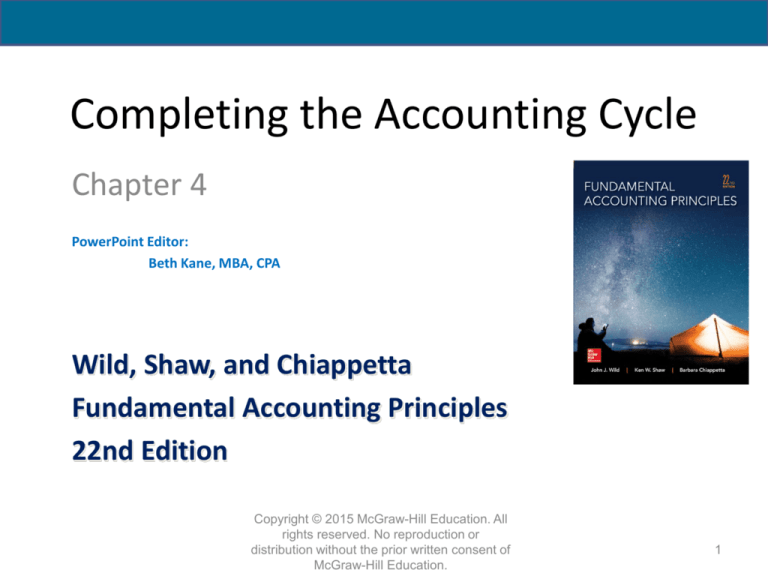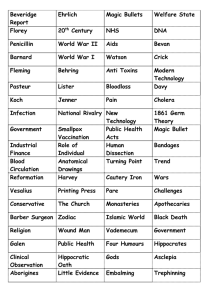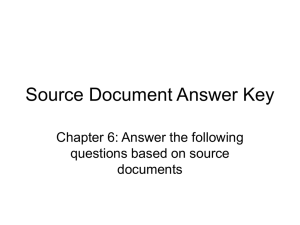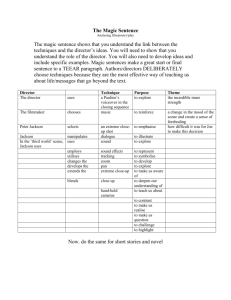
Completing the Accounting Cycle
Chapter 4
PowerPoint Editor:
Beth Kane, MBA, CPA
Wild, Shaw, and Chiappetta
Fundamental Accounting Principles
22nd Edition
Copyright © 2015 McGraw-Hill Education. All
rights reserved. No reproduction or
distribution without the prior written consent of
McGraw-Hill Education.
1
04-P1: Benefits of a Work
Sheet
2
The Worksheet
• An internal document that serves as a useful
tool for organizing accounting information.
• Not a required report
3
Benefits of a Work Sheet
Aids the
preparation of
financial
statements.
Reduces
possibility of
errors.
Links accounts
and their
adjustments.
P1
Assists in
planning and
organizing an
audit.
Not a
required
report.
Helps in
preparing
interim financial
statements.
Shows the
effects of
proposed
transactions.
4
Steps to prepare a worksheet
1. Enter unadjusted trial balance
• From current balances on the ledger
2. Enter the adjustments
3. Prepare the Adjusted Trial balance
4. Sort the adjusted trial balance amounts to the
appropriate financial statement columns
5. Total statement columns, compute net income/loss
5
NEED-TO-KNOW
The following 10-column work sheet contains the year-end unadjusted trial balance for Magic Company
as of December 31, 20X2. Complete the work sheet by entering the necessary adjustments, computing the adjusted
account balances, extending the adjusted balances into the appropriate financial statement columns, and entering
the amount of net income for the period. Note: The Magic, Capital account balance was $75,000 at December 31, 20X1.
No.
101
106
183
201
251
301
302
401
622
650
Unadjusted
Trial Balance
Dr.
Cr.
Cash
13,000
Accounts receivable
8,000
Land
85,000
Accounts payable
10,000
Long-term notes payable
33,000
Magic, Capital
75,000
Magic, Withdrawals
20,000
Fees earned
70,000
Salaries expense
54,000
Office supplies expense
8,000
Totals
188,000 188,000
Adjustments
Dr.
Cr.
Adjusted
Trial Balance
Dr.
Cr.
Income
Statement
Dr.
Cr.
Balance Sheet
and Statement of
Owner's Equity
Dr.
Cr.
1. Prepare and complete the work sheet, starting with the unadjusted trial balance and including adjustments
based on the following.
a. The company has earned $9,000 in fees that were not yet recorded at year-end.
b. The company incurred $2,000 in salary expense that was not yet recorded at year-end.
(Hint: For simplicity, assume it records any salary not yet paid as part of accounts payable.)
c. The long-term note payable was issued on December 31 this year. Thus, no interest has yet accrued
on this loan.
P1
6
No.
101
106
183
201
251
301
302
401
622
650
Unadjusted
Adjusted
Trial Balance
Trial Balance
Adjustments
Dr.
Cr.
Dr.
Cr.
Dr.
Cr.
Cash
13,000
13,000
Accounts receivable
8,000
(a) 9,000
17,000
Land
85,000
85,000
Accounts payable
10,000
(b) 2,000
12,000
Long-term notes payable
33,000
33,000
Magic, Capital
75,000
75,000
Magic, Withdrawals
20,000
20,000
Fees earned
70,000
(a) 9,000
79,000
Salaries expense
54,000
(b) 2,000
56,000
Office supplies expense
8,000
8,000
Totals
188,000 188,000
11,000
11,000 199,000 199,000
Net income
Totals
Income
Statement
Dr.
Cr.
Balance Sheet
and Statement of
Owner's Equity
Dr.
Cr.
13,000
17,000
85,000
12,000
33,000
75,000
20,000
79,000
56,000
8,000
64,000
15,000
79,000
79,000 135,000 120,000
15,000
79,000 135,000 135,000
a. The company has earned $9,000 in fees that were not yet recorded at year-end.
b. The company incurred $2,000 in salary expense that was not yet recorded at year-end.
(Hint: For simplicity, assume it records any salary not yet paid as part of accounts payable.)
c. The long-term note payable was issued on December 31 this year. Thus, no interest has yet accrued
on this loan.
P1
7
No.
101
106
183
201
251
301
302
401
622
650
Unadjusted
Adjusted
Trial Balance
Trial Balance
Adjustments
Dr.
Cr.
Dr.
Cr.
Dr.
Cr.
Cash
13,000
13,000
Accounts receivable
8,000
(a) 9,000
17,000
Land
85,000
85,000
Accounts payable
10,000
(b) 2,000
12,000
Long-term notes payable
33,000
33,000
Magic, Capital
75,000
75,000
Magic, Withdrawals
20,000
20,000
Fees earned
70,000
(a) 9,000
79,000
Salaries expense
54,000
(b) 2,000
56,000
Office supplies expense
8,000
8,000
Totals
188,000 188,000
11,000
11,000 199,000 199,000
Net income
Totals
Income
Statement
Dr.
Cr.
Balance Sheet
and Statement of
Owner's Equity
Dr.
Cr.
13,000
17,000
85,000
12,000
33,000
75,000
20,000
79,000
56,000
8,000
64,000
15,000
79,000
79,000 135,000 120,000
15,000
79,000 135,000 135,000
2. Use information from the completed work sheet in part 1 to prepare adjusting entries.
Date
General Journal
Dec. 31 Accounts Receivable
Debit
9,000
Fees earned
Dec. 31 Salaries expense
Accounts payable
Credit
9,000
2,000
2,000
Dec. 31 No journal entry required
P1
8
3. Prepare the income statement and the statement of owner’s equity for the year ended December 31 and
the unclassified balance sheet at December 31.
Debit
$13,000
17,000
85,000
Cash
Accounts receivable
Land
Accounts payable
Long-term notes payable
Magic, Capital
Magic, Withdrawals
20,000
Fees earned
Salaries expense
56,000
Office supplies expense
8,000
Totals
$199,000
Credit
$12,000
33,000
75,000
79,000
$199,000
Magic Company
Income Statement
For Year Ended December 31, 20X2
Fees earned
$79,000
Expenses
Salaries expense
$56,000
Office supplies expense 8,000
64,000
Net income
$15,000
Magic Company
Statement of Owner’s Equity
For Year Ended December 31, 20X2
Magic, Capital, Dec. 31 20X1
$75,000
Plus: Net income
15,000
Less: Magic, Withdrawals
(20,000)
Magic, Capital, Dec. 31 20X2
$70,000
Magic Company
Balance Sheet
December 31, 20X2
Assets
Cash
Accounts receivable
Land
P1
Total assets
$13,000
17,000
85,000
$115,000
Liabilities
Accounts payable
Long-term notes payable
Total liabilities
Equity
Magic, Capital
$12,000
33,000
45,000
Total liabilities and equity
115,000
70,000
9
04-C1: Closing Process
• An important step at the end of the accounting
period AFTER financial statements have been
completed.
• It prepares accounts for recording transactions
and events for the next period.
10
4 - 11
Recording Closing Entries
1. Resets revenue,
expense, and
withdrawal account
balances to zero at
the end of the period.
2. Helps summarize a
period’s revenues and
expenses in the
Income Summary
account.
C1
Identify accounts
for closing.
Record and post
closing entries.
Prepare post-closing
trial balance.
11
4 - 12
Temporary Accounts
Temporary
Accounts
Income
Summary
C1
Withdrawals
Expenses
Revenues
They are temporary because
the accounts are opened at
the beginning of a period,
used to record transactions
and events for that period,
and then closed at the end of
the period.
The closing process
applies only to
temporary accounts.
12
4 - 13
Permanent Accounts
C1
Liabilities
Permanent
Accounts
Owner’s
Capital
Permanent (or real)
accounts report on
activities related to one or
more future accounting
periods.
They carry their ending
balances into the next
period and generally
consist of all balance sheet
accounts.
Assets
The closing process
applies only to
temporary accounts.
13
4 - 14
Temporary and
Permanent Accounts
Income
Summary
C1
Liabilities
Permanent
Accounts
Owner’s
Capital
Temporary
Accounts
Assets
Withdrawals
Expenses
Revenues
The closing process
applies only to
temporary accounts.
14
04-P2: Recording Closing
Entries
15
4 - 16
Recording Closing Entries
1. Close Credit Balances in
Revenue Accounts to Income
Summary.
2. Close Debit Balances in
Expense accounts to Income
Summary.
3. Close Income Summary
account to Owner’s Capital.
4. Close Withdrawals to Owner’s
Capital.
P2
16
4 - 17
Income Summary Account
• A temporary account only used for the closing
process
• Contains a credit for the sum of all revenues
(and gains)
• Contains a debit for the sum of all expenses
(and losses)
• Balance equals net income/loss
• Transfer balance to capital account
17
NEED-TO-KNOW
Use the adjusted trial balance of Magic Company to prepare its closing entries.
Magic Company
Trial Balance
December 31, 20X2
Debit
Cash
$13,000
Accounts receivable
17,000
Land
85,000
Accounts payable
Long-term notes payable
Magic, Capital
Magic, Withdrawals
Fees earned
Salaries expense
Office supplies expense
Totals
P2
Credit
$12,000
33,000
75,000
20,000
79,000
56,000
8,000
$199,000
$199,000
18
Debit
$13,000
17,000
85,000
Cash
Accounts receivable
Land
Accounts payable
Long-term notes payable
Magic, Capital
Magic, Withdrawals
20,000
Fees Earned
Salaries expense
56,000
Office supplies expense
8,000
Totals
$199,000
Date
Dec. 31
Dec. 31
Dec. 31
Dec. 31
P2
Credit
Expenses
Closing
$12,000
33,000
75,000
79,000
Income summary
64,000
Revenues
Net income
15,000
79,000
15,000
0
Magic, Capital
12/31/20X1
Magic, Withdrawals 20,000 Net income
12/31/20X2
75,000
15,000
70,000
$199,000
General Journal
Fees Earned
Income summary
Debit
79,000
Credit
79,000
Income summary
Salaries expense
Office supplies expense
64,000
Income summary
Magic, Capital
15,000
Magic, Capital
Magic, Withdrawals
20,000
56,000
8,000
15,000
20,000
19
Cash
Accounts receivable
Land
Accounts payable
Long-term notes payable
Magic, Capital
Totals
Debit
$13,000
17,000
85,000
Credit
Expenses
Closing
$12,000
33,000
70,000
$199,000
$115,000
$199,000
$115,000
Income summary
64,000
Revenues
Net income
15,000
79,000
15,000
0
Magic, Capital
12/31/20X1
Magic, Withdrawals 20,000 Net income
12/31/20X2
75,000
15,000
70,000
Magic Company
Balance Sheet
December 31, 20X2
Assets
Cash
Accounts receivable
Land
$13,000
17,000
85,000
Liabilities
Accounts payable
Long-term notes payable
Total liabilities
Equity
Magic, Capital
Total assets
P2
$115,000
Total liabilities and equity
$12,000
33,000
45,000
70,000
115,000
20
04-P3: Post-Closing Trial
Balance
21
Post-Closing Trial Balance
List of permanent
accounts and their
balances after posting
closing entries.
Total debits and credits
must be equal.
P3
22
Post-Closing Trial Balance
P3
23
04-C2: Accounting Cycle
24
4 - 25
Accounting Cycle
C2
25
04-C3: Classified Balance
Sheet
26
4 - 27
Classified Balance Sheet
Current items are those expected to come due (both
collected and owed) within the longer of one year or
the company’s normal operating cycle.
C3
27
4 - 28
Current Assets
Current assets are expected to be sold,
collected, or used within one year or the
company’s operating cycle.
C3
28
4 - 29
Long-Term Investments
Long-term investments are expected to be held for
more than one year or the operating cycle.
C3
29
4 - 30
Plant Assets
Plant assets are tangible long-lived assets used to
produce or sell products and services.
C3
30
4 - 31
Intangible Assets
Intangible assets are long-term resources used to
produce or sell products and services and that
lack physical form.
C3
31
4 - 32
Current Liabilities
Current liabilities are obligations due within the longer of
one year or the company’s operating cycle.
C3
32
4 - 33
Long-Term Liabilities
Long-term liabilities are obligations not due within
the longer of one year or the company’s operating
cycle.
C3
33
4 - 34
Equity
Equity is the owner’s claim on the assets.
C3
34
NEED-TO-KNOW
Use the adjusted trial balance of Magic Company to prepare its classified
balance sheet as of December 31, 20X2.
Magic Company
Adjusted Trial Balance
December 31, 20X2
Debit
Cash
$13,000
Accounts receivable
17,000
Land
85,000
Accounts payable
Long-term notes payable
Magic, Capital
Magic, Withdrawals
20,000
Fees earned
Salaries expense
56,000
Office supplies expense
8,000
Totals
$199,000
C3
Credit
$12,000
33,000
75,000
79,000
$199,000
35
NEED-TO-KNOW
Use the adjusted trial balance of Magic Company to prepare its classified balance sheet as of
December 31, 20X2.
Magic Company
Adjusted Trial Balance
December 31, 20X2
Debit
Cash
$13,000
Accounts receivable
17,000
Land
85,000
Accounts payable
Long-term notes payable
Magic, Capital
Magic, Withdrawals
20,000
Fees earned
Salaries expense
56,000
Office supplies expense
8,000
Totals
$199,000
C3
Credit
$12,000
33,000
75,000
79,000
$199,000
Magic Company
Balance Sheet
December 31, 20X2
Assets
Current assets
Cash
Accounts receivable
Total current assets
Plant assets
Land
Total plant assets
Total assets
Liabilities
Current liabilities
Accounts payable
Total current liabilities
Long-term liabilities
Long-term notes payable
Total liabilities
Equity
Magic, Capital
85,000
85,000
$115,000
Total liabilities and equity
$115,000
$13,000
17,000
30,000
$12,000
12,000
33,000
$45,000
70,000
36
4 - 37
Global View
The definition of an asset is similar under U.S. GAAP and IFRS and
involves three basic criteria:
(1) the company owns or controls the right to use the item,
(2) the right arises from a past transaction or event, and
(3) the item can be reliably measured.
Both systems define the initial asset value as historical cost for
nearly all assets.
The definition of a liability is similar under U.S. GAAP and IFRS and
involves three basic criteria:
(1) the item is a present obligation requiring a probable future resource
outlay,
(2) the obligation arises from a past transaction or event, and
(3) the obligation can be reliably measured.
37
04-A1: Current Ratio
38
4 - 39
Current Ratio
Helps assess the company’s ability to pay its
debts in the near future
Current ratio =
Current assets
Current liabilities
Limited Brands, Inc.
A1
39
04-P4: Reversing Entries
40
4 - 41
Appendix 4A – Reversing Entries
Reversing entries are optional. They are recorded in
response to accrued assets and accrued liabilities that
were created by adjusting entries at the end of a
reporting period. The purpose of reversing entries is to
simplify a company’s recordkeeping.
Let’s see how the accounting for our payroll
accrual will be handled with and without
reversing entries.
P4
41
4 - 42
P4
42
4 - 43
Without Reversing Entries
P4
With Reversing Entries
43
4 - 44
End of Chapter 4
44







